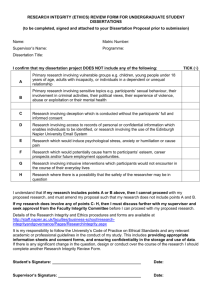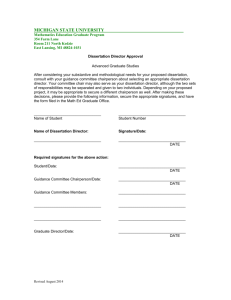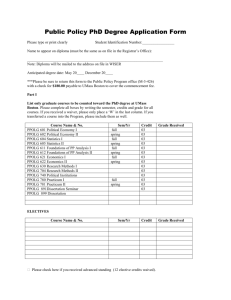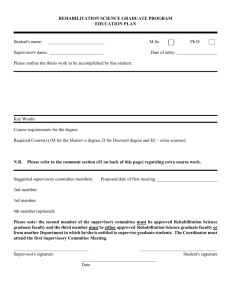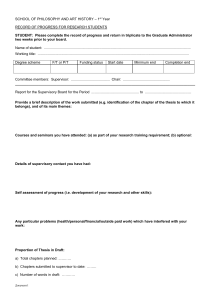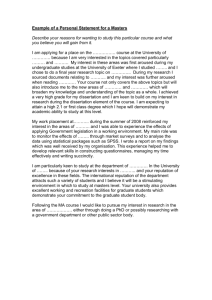Guidelines for Dissertation Proposals
advertisement
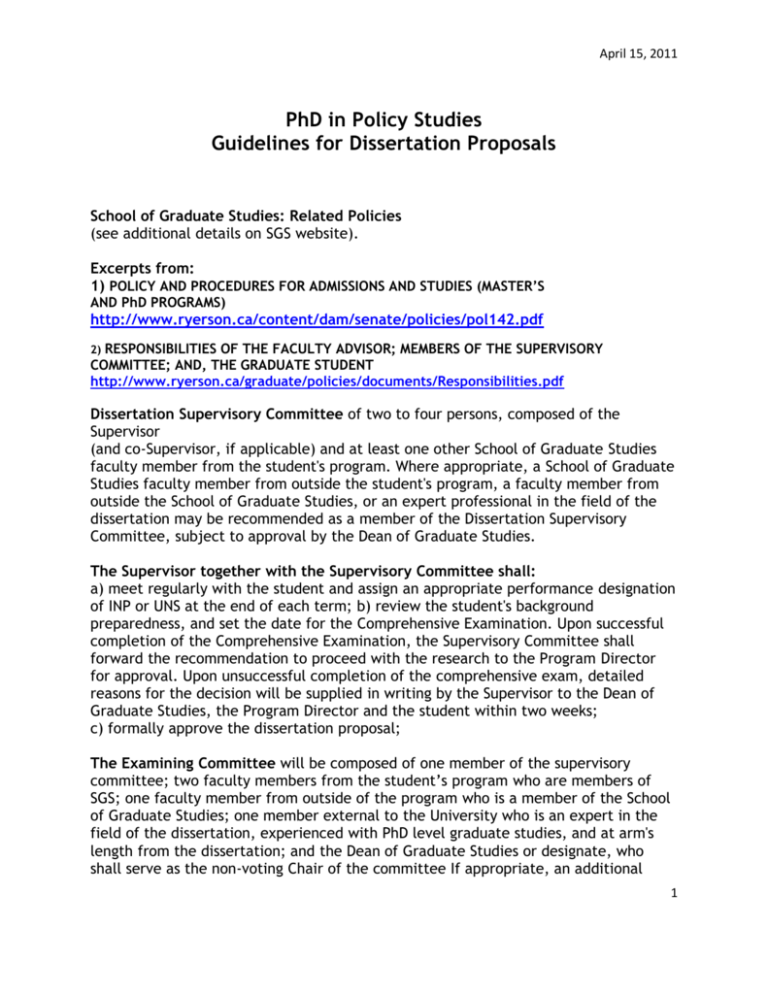
April 15, 2011 PhD in Policy Studies Guidelines for Dissertation Proposals School of Graduate Studies: Related Policies (see additional details on SGS website). Excerpts from: 1) POLICY AND PROCEDURES FOR ADMISSIONS AND STUDIES (MASTER’S AND PhD PROGRAMS) http://www.ryerson.ca/content/dam/senate/policies/pol142.pdf RESPONSIBILITIES OF THE FACULTY ADVISOR; MEMBERS OF THE SUPERVISORY COMMITTEE; AND, THE GRADUATE STUDENT http://www.ryerson.ca/graduate/policies/documents/Responsibilities.pdf 2) Dissertation Supervisory Committee of two to four persons, composed of the Supervisor (and co-Supervisor, if applicable) and at least one other School of Graduate Studies faculty member from the student's program. Where appropriate, a School of Graduate Studies faculty member from outside the student's program, a faculty member from outside the School of Graduate Studies, or an expert professional in the field of the dissertation may be recommended as a member of the Dissertation Supervisory Committee, subject to approval by the Dean of Graduate Studies. The Supervisor together with the Supervisory Committee shall: a) meet regularly with the student and assign an appropriate performance designation of INP or UNS at the end of each term; b) review the student's background preparedness, and set the date for the Comprehensive Examination. Upon successful completion of the Comprehensive Examination, the Supervisory Committee shall forward the recommendation to proceed with the research to the Program Director for approval. Upon unsuccessful completion of the comprehensive exam, detailed reasons for the decision will be supplied in writing by the Supervisor to the Dean of Graduate Studies, the Program Director and the student within two weeks; c) formally approve the dissertation proposal; The Examining Committee will be composed of one member of the supervisory committee; two faculty members from the student’s program who are members of SGS; one faculty member from outside of the program who is a member of the School of Graduate Studies; one member external to the University who is an expert in the field of the dissertation, experienced with PhD level graduate studies, and at arm's length from the dissertation; and the Dean of Graduate Studies or designate, who shall serve as the non-voting Chair of the committee If appropriate, an additional 1 April 15, 2011 member may be recommended who is an expert professional in the field of the dissertation, or a Ryerson University faculty member who is not a member of the School of Graduate Studies. Guidelines for Dissertation Proposals PhD in Policy Studies Supervisor On admission to the program a student will be tentatively assigned an “Advisor” from the list of potential supervisors they identified in their application or another faculty member with expertise in the area of the student’s research. It is expected that students will meet with their Advisor and other potential supervisors in Year 1. By the end of Year 1 students will be required to select their supervisor and submit the relevant form to the Program Director for approval. Supervisory Committee The student’s Supervisory Committee shall be comprised of his/her Supervisor and at least two additional faculty members affiliated with the program (one of which must be from the student’s chosen field). It is expected that a student’s supervisory committee be established by the Fall of Year 2. Submitting the Proposal The student shall submit a written draft of the proposal (20-30 pages double spaced) to his/her Supervisor and then committee members for feedback and preliminary approval. Each time a document is submitted for feedback and approval to members of the Supervisory Committee, the student should allow a minimum of 2 weeks for feedback. Typically the final draft will be submitted by the end of the winter term in Year 2. After preliminary approval of the document has been granted by the Supervisor and Supervisory Committee, the student will be asked to submit the final copy to the Director of the program so an oral presentation can be scheduled. The copy to be presented should be submitted to the Program Administrator so it can be posted on Blackboard. The oral presentation should ideally be scheduled by the Spring of Year 2, to allow dissertation research to begin in spring/summer term of Year 2. The dissertation proposal should not be submitted any later than end of Year 2 (end of August). Oral Presentation of the Proposal The student is required to orally present the proposal to his/her supervisory committee, members of the field and any other interested faculty and students from the program. This will normally be done by the end of Year 2 or Fall of Year 3 at the latest. 2 April 15, 2011 It is the responsibility of the Supervisor to ensure that the comments and suggestions are incorporated after the oral presentation. If the proposal is initially rejected, the student shall be allowed a maximum of two additional submissions to receive approval. Final Approval and Submission of the Proposal Final approval of the proposal is the responsibility of the Supervisor and Supervisory Committee. A cover sheet (Dissertation Proposal for the PhD Degree) bearing the approval signature of the Supervisor and each committee member shall be attached to the final proposal and submitted to the Program Director/Administrator. 3 April 15, 2011 Format of the Dissertation Proposal PhD in Policy Studies DRAFT 1. Title Page Candidate’s name, student number, field, program name, title, date, Supervisor and members of Supervisory Committee should be included in the title page. 2. Abstract The abstract is expected to be brief (not to exceed 350 words) and should summarize the following: Introduction, Statement of the Problem, Background of the Study, Research Questions or Hypotheses, and Methods and Procedures. 3. Introduction This section introduces the reader to the study and provides a general overview of the circumstances, issues, and background leading up to the problem/topic under investigation. 4. Background of the Study, Literature Review & Conceptual Framework This section should include a review of the relevant theoretical and empirical works which provide a broad background and theoretical grounding to the study. The scope of the project should be clearly outlined. This section should indicate that the candidate has a good working knowledge of the literature relevant to their field of study. They should discuss the current state of knowledge, its present limitations and how their study fits into theory and knowledge in the field. They should also indicate the extent to which their study will result in an original contribution in their field. 5. Research Questions/Hypotheses Research questions or hypotheses should be stated clearly. These should flow logically from the discussion of the Background of the Study and should be consistent with the Statement of the Problem. 6. Methods and Procedures This section should indicate what type of study is being conducted, how the study will be conducted, what data or information will be used, how it will be obtained. The research method section should include overall research design, delineation of the method and procedures for executing it. Thus, the section should convey the appropriateness of the data/information for answering the research questions; and describe the techniques for analyzing the data with direct reference to the research questions or hypotheses. 4 April 15, 2011 If your research involves working with human subjects, this section should also outline the ethics approval procedures which will need to be completed and submitted to the Ryerson Ethics Board prior to initiating the study. The proposal requirements are not fully satisfied until ethics approval has been granted. 7. Limitations and Delimitations A limitation identifies potential weaknesses of the study. A delimitation addresses the scope of the study, things you are not doing and why you have chosen not to do them. This section should be based on things that a reader might reasonably expect you to do, but for clearly explained reasons, you have decided not to do. 8. Timelines A timeline or table detailing the planned progress of the project must be included. Milestones against which progress can be monitored and assessed should be identified. 9. Figures and Tables The inclusion of explanatory figures and tables is encouraged. They may be used in appropriate places in the document. A tentative dissertation outline is also encouraged. 10. References All references cited in the proposal should be included. Consult with your supervisor if other references should be included beyond those directly cited in your proposal. 11. Appendices [if applicable] 5 April 15, 2011 DRAFT - Criteria for Assessment of Dissertation Proposals PhD in Policy Studies Introduction and Statement of the Problem: Does the introduction provide a general overview of the issues surrounding the study? Is the problem under investigation clearly stated? Is evidence used to demonstrate the significance of the problem? Are important terms defined? Are assumptions clearly stated? Are major assertions that lay ground work for the study articulated? Background and Review of the Literature: Is the study grounded in a larger body of research? Is the review current and representative of work in the area? Are related studies examined critically and gaps identified? Does the review provide a clear rationale of the study? Is the review well organized, using sub-sections where appropriate? Research Questions/Hypotheses: Do the research questions/hypotheses develop a specific focus for the study? Do the questions/hypotheses support the problem statement and background sections? Methodology and Limitations: Is the research design described clearly and appropriate for the study? Are the sample and participants fully described? Are data gathering procedures fully explicated and appropriate for the study? Are analytical procedures fully explicated and appropriate for the study? Is the technical merit of instruments described clearly? Are issues related to limitations and/or trustworthiness satisfactorily identified and addressed? Do the sampling, data collection, and analytical procedures appropriately match the problem statement and research questions? Are the instruments or interview guides acceptable and appropriate for the study? Other: Does the proposal demonstrate a high quality of written expression? Does a consistent conceptual framework unite the problem statement, research questions, and methods section? Are applicable supporting documents included and satisfactory? Is an appropriate citation style used correctly and consistently? Does the proposed study adhere to conventional wisdom related to ethics? 6 April 15, 2011 Does the abstract summarize the contents of the proposal clearly and accurately? Issues related to the Literature Review: Given that the comprehensive exam is primarily a literature review in the dissertation proposal the literature should interweave into the background, research questions and methods sections. This informs the reader of what we do know and what we need to know. This serves to bolster the argument which you are crafting. Rather than summarizing the various pieces of literature in detail (by reviewing the methods and the dependent variable and the findings) you should be explaining what matters about that study. Only when there is direct bearing on the study you are doing, might you want to describe a study in depth. Regardless of what organizational strategy you use to present the literature, keep in mind to do an ANALYSIS of the literature. What are the conceptual and methodological strengths and weaknesses? What are the things we can say with confidence, and what is speculative and tentative? What is clearly established and what is missing? By identifying the gaps, you can locate your own research. By the end of the proposal you want the reader to be convinced - both of the importance of this research and of your way of researching it. 7
